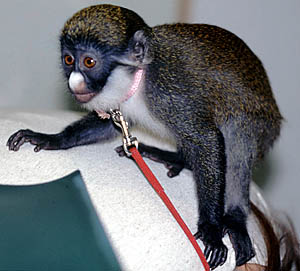
Lesser spot-nosed monkey (Cercopithecus petaurista)
Phylum —chordata
Class — mammalia
Order — primates
Family — cercopithecidae
Genus –cercopithecus
Appearance
This is a small arboreal species with a long tail. The face is black with a white nose spot. A white stripe extends from the temple to below the ear. The crown, back, outer side of the limbs and upper surface of the tail are olive-green or khaki. In some forms, the middle and lower back have a reddish tinge. The individual hairs, especially on the crown, are flecked with black and yellow. The underparts, inner side of the limbs and underside of the tail are white or cream.
Weight – 4-5 kg, length – 40-50 см.
Habitat
Lesser spot-nosed monkeys are found in West Africa. Their range includes Guinea-Bissau, Guinea, Sierra Leone, Liberia, Ivory Coast, Ghana, Togo, and in southeastern Senegal.
Behavior
Lesser spot-nosed monkeys are diurnal, arboreal and cryptic creatures. Being active during the day they move through the forest cautiously, seldom climbing to the high canopy. They prefer the understorey layers and lianas. Lesser spot-nosed monkeys are very social animals. They form groups of about ten animals that usually consist of one adult male, several adult females and their young. When foraging these monkeys often store their food in cheek pouches. When the pouches are full they become prominent and the white throat of the monkey resembles a snowball.
Diet
Lesser spot-nosed monkeys are omnivorous animals. They feed on leaves, fruit, flowers and insects.
Reproduction
Little is known about the mating system and reproduction of Lesser spot-nosed monkeys. These animals don't breed seasonally. Females give birth to a single infant that weighs around 230 g at birth. The gestation period lasts about seven months.
The Lesser spot-nosed monkey has an average life expectancy of 17-19 years.
In captivity
Monkeys are very smart and sociable creatures, they have a lot in common with humans, but in no case should such a pet be allowed to walk around the house or apartment without human supervision. He is interested in everything, wants to touch everything and even see what is inside, so he breaks everything that comes to hand.
First of all, it is necessary to provide a fairly spacious and strong cage for the monkey, which is recommended to be made of strong wood, the front wall is usually made of metal rods. Connections bolts or screws are not allowed.
Suitable cell size 2x1, 5x1, 5 m. Monkeys usually lead a very active lifestyle, so the cage should have different devices for climbing. Most often, a trapeze is installed for monkeys, which is a wooden shelf attached with strong ropes or chains. You can install a pole with a movable wheel or hang a large ring made of metal or ebony from the ceiling. The best entertainment for your pet will be a mirror that is well nailed or glued, the frame for it must be made of solid wood. The mirror must be fixed motionless, otherwise a curious monkey can break it, and then swallow the fragments.
A monkey is not a very clean animal. Therefore, the bottom of the cage should be covered with a layer of dry sawdust, preferably spruce. For feeding monkeys, feeders are usually used, water is given in drinkers. These devices should not be kept in the cage all the time.
For keeping monkeys, in addition to cages, sometimes use aviaries or keep them in poles. This device is a pole where there is a horizontal platform used for walking and feeding the animal, as well as a place to sleep. This is probably the most cruel keeping of an animal, because in this case the monkey must always be on a leash. We recommend not to torment your pet, but still provide it with a good home. For example, aviaries are much more suitable for keeping monkeys. They are much more spacious than cells and they can have conditions that are closest to nature. To do this, the keeper should have the aviary with tree branches or plant various types of vegetation.
Periodically, your pet should be walked. To do this, they need to wear a belt with a leash. It can be made from a soft but strong leather belt that will wrap around the animal's body slightly below the shoulders. It is necessary to train the monkey to this belt since the very childhood and not to remove it even in the apartment.
Feed the monkeys twice a day, sometimes you can give them various fruits as rewards, but do not overuse this. Monkeys, like all primates, eat mainly plant food, preferring plant shoots, fruits, flowers and nuts. In addition to plant food, you can add small insects, worms, sometimes even shellfish and crabs. It is recommended to give them boiled rice with milk and a white bun soaked in milk, and you should also add fruit; some favor boiled potatoes and vegetables in general (tomatoes, carrots, cabbage, beets, boiled corn). For almost all monkeys, watermelon is a treat. Very quickly, monkeys get used to various exotic fruits, and if you give them often, they completely refuse other food, so bananas and oranges are recommended to be given quite rarely. Onions (contain vitamin C) are very useful for monkeys, but since it is very corrosive to the eyes, they make interesting grimaces before using it. Sometimes they should be given cereal and legume seeds.
The amount of feed is important. Monkeys are very fond of eating, often overeating. If the stomach is already full, they will fill the cheek bags, and if there is anything left, they will hide it in the most unpredictable places, and if there is no place to keep food it can be scattered in a cage or in an apartment.
 Russian
Russian
 English
English























